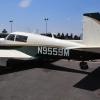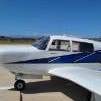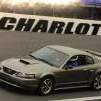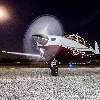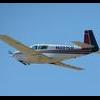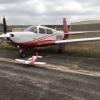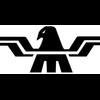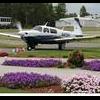Leaderboard
Popular Content
Showing content with the highest reputation on 05/10/2013 in all areas
-
All I can say is read and learn as much as you can about Mooneys. I spent A LOT of time reading and looking at Mooneys for sale before I found one I liked. I bought mine for over10k less than it's original asking price. Remember, it's a buyer's market right now. I can't think of a better time to buy an airplane, in recent history, other than now. I may offend some people here, but I think the J model might be the best model ever offered when you consider speed, economy and value (Assuming you care how much fuel you burn). I have a friend looking at buying an airplane and he said after doing research on Mooneys the J seems like it makes the most sense. I agree with everything MooneyMite and others have said but I slightly disagree with some other posts regarding airframe total time being a factor. I wouldn't hesitate about planes with a lot of hours. Mooneys are well built. I fly a helicopter at work with over 12,000 hours on it. I would steer away from a 30 yr old plane with low hours as it shows the plane probably didn't fly much and that's not good if the engine is still the original engine. And as KSMooniac said, if you're serious, get with someone on the forum to take you for a ride. FlyDave was kind enough to take me up in his Mooney when I was still deciding if the Mooney was right for me. Today we are good friends and he actually helped fly my plane back across the country with me from NC to CA. Good luck and feel free to PM me if you have any questions about Mooney ownership.2 points
-
I purchased mine 2 years ago. Here are the parameters that I found affect price the most. 1: Avionics. 2: General Condition 3; Engine Time 4 Total Time 5: WHat the owner thinks he needs to sell it. Sometimes 5 becomes number 1. My plane was on the market for about 6 months at 10k more than what I paid. He slowly dropped the price and then I made a take it or leave it offer with reasons. He took it. My requirements were quite strict, must be within 2 hrs flight time, and E or F and GPS with Autopilot. Took me about 8 months to find my plane. BILL2 points
-
I admit that I was looking for a Piper Arrow, back in 1984 when I wound up buying a 1967 M20F. The interesting part is that I still own it. It has, over the years, been upgraded beyond any reasonable resale price, but the airplane has been a joy to fly for almost 30 years, and I feel that the utility that I have received, has been well worth the expense. It is not unusual to see Mooney owners do this. I believe it is because they truly enjoy the way the airplane flies, and the inherent safety of the airframe. This model Mooney provides a great combination of speed, economy, useful load, range, and reliability. After flying one for 29 years, there is not another single engine airplane that I would rather own.2 points
-
1 point
-
Join MAPA which gives you a subscription to the MAPA Log magazine, and then read the regular articles on valuation of Mooney aircraft. Once you get one of the charts in the magazine for your class of Mooney, you can run the numbers yourself to get an idea of value.1 point
-
Scott is absolutely right about no expectations of recovering costs for a full "remanufacture", but sometimes an esthetic is the most important consideration. In contrast with some who have chosen to follow this pathway, I do not expect to fly her long enough to reasonably amortize the costs involved. I'm 78 now, and I will "hang up the keys" for the Mooney, at least, when I am 80. Still can pass my aviation physicals, but age just creeps up on you, and I think it prudent to quit "winners" after more than thirty years of accident (and incident) free flying. Still toying with the idea of buying an Ercoupe (LSA version), to keep in a hangar out in the boonies, and just fly her locally, strictly VFR, just to keep a hand in flying in my 80s. A good friend, and A&P, of about my age is willing to maintain her for the consideration of flying her occasionally. A couple of old fogies with many thousands of hours between us just flying low and slow in a simple airplane for the pure pleasure of it has a certain attraction, but not until I have taken my J back across the country a few more times, and then back to the British West Indies, and then to revisit still more places in the Caribbean.1 point
-
As our planes get older, the price ranges will increase considerably. At one end is the un-loved, un-upgraded vintage plane with original panel, nasty interior, and faded paint. It might or might not be airworthy. At the other end is the fully modernized example with great cosmetics, re-sealed tanks, autopilot, etc. This price range might be $20k-$100k for a C/E/F, although you won't find many $100k pre-J models because the ones with that much invested will likely only come up during an estate sale. You can pour way more than $100k (total) into any vintage Mooney and not be able to sell it for $80k, too. Having said that, there are quite a few threads on this site about buying vintage Mooneys, so you might spend a couple hours reading through those. http://www.themooneyflyer.com/ has a great evaluation tool based on our expert Mooney broker/evaluator so you can play around there and get a better idea what the goodies are worth when you compare various planes. IMO, avionics and especially autopilots are the biggest factors these days. I'm already assuming a great, well-maintained airframe without corrosion or major/questionable damage history as I wouldn't buy a plane with such issues. Minor damage history like a gear-up landing, hangar rash, etc. is not a deal-breaker in most cases. Avionics and other upgrades typically only return 50% of the cost at sale time, so you're always better off spending more at purchase vs. adding stuff later, financially-speaking. However, if you plan to own the plane for a long time (say 10+ years) then buying a project and upgrading to your specs and enjoying your upgrades for years isn't crazy. (I bought a near-premium J and have continued sinking money into improvements). Just to start you in a more realistic frame of mind, you're very unlikely to find speed brakes (not necessary) or a strike finder/stormscope in most vintage Mooneys. XM or ADS-B weather is much easier/simpler and will be "good enough" to go without a spherics device unless you're a risk-taker. Most vintage Mooneys have the vacuum-based Positive Control (PC) system which is a full-time wing leveler. They might have the add-on Brittain autopilot system that can work well and is inexpensive, but it is better than nothing. If you're lucky, you might find one with an STEC and that would be a great find since installing an STEC these days can cost $15-20k easily, and not many folks will spend that much on a $50k plane. Any vintage Mooney can get you to either coast in a day of flying from the Plains. I'm looking at trip to Delaware in July and it is only ~7 hours of flight time from Wichita in my J. I've previously flown to FL, CA, and nearly everywhere in between... If you want a ride, post your location and you can likely find one of us nearby!1 point
-
Define you mission first. Where you plan on flying, what type of flying VFR/IFR, how long of trips, how many people how much baggage. Sounds like you may have done that already since you keep coming back to the same manufacturer and type.<br /><br />Secondly define what you want in it avionics paint speed mods etc. Like one of the other posts get as much as you want in the plane up front it is cheaper and easier than modifying it yourself. Myself I found both of my planes in several months each. My first plane I did not know very much but I was looking for something that I could get into the air with and I found a 1964 E model. My second plane with more knowledge and IFR rating changed some of the things I was looking for. I put looks last because at 10k feet no one on the ground can see what shape the paint is in. I have avionics at the top since that is what I use to fly the plane and what I interface with the most. In the end all have to come together with compromises in each catagory.<br /><br />1. Avionics<br />2. Mechanical condition<br />3. looks<br />1 point
-
When it comes to Mooney prices, the devil is in the details. The details are: hours on the engine, avionics, general condition (paint and interior) and history. After that, there's other equipment installed and how well a particular airplane suits you. It's not uncommon to see the same basic model priced many thousands of dollars apart...and for good reason. In my opinion, money-wise, you're best off to wait and find exactly the plane you want than to buy one and then up-date/modify to suit. However, some folk would rather customize an aircraft to their taste. Generally Controller's prices are "on the high end". I suspect actual selling prices are significantly less, but there's no way to know and track that sort of info. Personally, I like to follow the listings on Barnstormers.com.1 point
-
Yes, we're at KPAO (N201CD). We flew over I-80 to Truckee and then more or less followed the V6 airway across NV (it pretty closely follows I-80 but is a little more direct than the freeway) to Elko (BQU VOR). From Elko it's a straight shot to Twin Falls, ID. After that, you can follow the wide Snake River valley towards KWYS. You will likely get some turbulence over NV unless you leave very early. After Twin Falls there are a series of lava flows that result in surface heating (they're black!) and turbulence. It's a pretty interesting area actually, a nice change from Nevada. Our return route was more complicated - over the park to Jackson, WY (Grand Teton) then south to Heber, UT, then home (actually we flew to Lakeport, CA from Heber, UT for a LASAR event and then home after that - that was a long day). All of this was with a family of 4 and camping gear. Rich1 point
-
It is said that the first 100 hundred hours are the safest, so congratulations but it is time to grow eyes in the back of your head. Take nothing lightly, especially not an engine misbehaving on takeoff. I don't fly a C so don't know the effect a boost pump would have, but does the C not have a Flight Manual that covers what position the pump should be in for takeoff and/or landing? In my K, boosts pumps are for emergencies only, primarily failure of the engine driven pump, and I have it in my checklist to check that they are off during takeoff and on landing. However, there are other things that can cause the symptoms you are describing. A small amount of water in the line. A magneto or both magnetos nearing the ends of their useful lives, possibly even a mag loose on the stem. So here is my suggestion, and it is what I do with my aircraft. If you don't have a good checklist for a C, find a good detailed checklist of the type a school would use. Use that as a form or outline, and then go through your flight manual and figure out what position each of the switches, controls, circuit breakers, etc. needs to be in, during each regime of flight, and put those in your checklist. Then use that checklist every time, every flight. I have a checklist in .pdf form for my K I would be glad to send you that you can use as an outline. It probably has more stuff than your C, and different stuff, but it would be a start. Then on your next flight, I would take care to perform a rigorous preflight and runup, and not accept anything out of standard. If the standard for you C is a mag drop of no more than 150 RPM's, then don't accept 151. If the difference between the mags is supposed to be 75 or less, don't accept 76. It is entirely possible the boost pump was the culprit, but it is possible something else was also. We have all made those mistakes. I left the mag on "L" instead of "Both" once and then had to abort because the engine ran rough on climb out. I figured it out, did a runup and test flight and it was ok. But you need to be fairly certain that you found the solution. If you are new to Mooneys and new to flying, I would not take for granted that I had found the solution. We have had people on this Board who are not on this Board any longer, or anywhere else in the living world for that matter. So don't just guess, is my advice.1 point
-
For all of you that ask I am a bit reluctant to share however the cost was $65,200 plus trade in credit of $13,200 for the 2 430's, and the other used avionics taken out of the Rocket plus two Bose headsets. The plane was tied up 4 weeks. And one of those weeks was due to auto pilot issues. I am a systems integrator and have worked with servos and automation for my entire career and when the auto pilot issue came up I told John I don t think it was the servo but remember I was not there and could not say for sure. I got some good advice from Byron and checked with his source who confirmed my suspicions but could not say for sure without testing the autopilot himself. John told me what they had checked and said it was the only thing he could not check himself... Long story short they sent the computer and trim servo off to be checked the next day I called John and ask him to overnight the pitch servo for test as well, which he did. While the unit was off being tested John found the problem in the conductors. John reported what the auto pilot company doing the test had found and that the problem was in the conductors he would stand good for auto pilot overnight and bench tests with no additional cost to me... what a relief to have someone stand behind their work and tell me the truth.. Because John Miller was completely truthful with me and especially without being prompted our warned to do so I happy paid him for his lost expenses. What a blessing it is to have someone be honest with you! Let me be clear I have no dog in this race, I did not know this man or his company before he did the work for me, for once just a story of a guy who did what he said he would do, for what he said he would do it for and it works just as he said it would, what more can I say! I will do business with John Miller again if I have the opportunity & I would highly recommend John Miller at Crystal Avionics in New Braunfels TX, oh and by the way his quote was the best I received from 4 of the recommended shops I checked with! Low enough that I made him confirm and recheck his quote twice, over 20k less than highest bidder! Also John added several other special request items such as the AOA, 2 additional 12VDC power outlets with the proper circuit breakers, remote handheld radio antenna connection, door seal controls and proper circuit interrupt, and repaired the gear down warning system. He also personally flew with me in the plane today for training with system and approaches etc! Lastly I am still behind the learning curve for sure but the SVT is more than I had hoped for, we flew a couple hours in IMC today, made approaches like it was VFR all I can say is WOW! I have had tablet SVT in my Saratoga for some time but nothing like flying SVT as your primary navigation!! I wont ever go back to steam gauges... well at least I hope I wont! Have not had sufficient VFR conditions to permit the calibration and use of the AOA, will advise when we get it set up!1 point
-
I have to concur with all of the others, but let me add my two cents. I will never forget the day that I landed at 11R during my "insurance sentence" and it was the second landing I ever made in my E. A Piper had just landed ahead of us and three guys got out. As I taxied towards them, the three just stared--I mean STARED to the point of creepy. I said to my CFI that something must be wrong, why were they staring? He said that they were staring at the plane because of how beautiful it was. My E is painted like an Acclaim and I confess that I fell in love with it based on looks--I did luck out that she is very mechanically sound as well. Once you fly a Mooney, and fly it well, I simply cannot imagine how you could go to anything else. This is what happens when you become a "Mooniac." It is not unlike how Porschephiles feel about 911's. In fact, the Mooney is the 911 of the GA aircraft world in so many ways. I know, I've worked on both of them. Not everyone can be a Mooniac, I am almost thinking you might not be happy being one. There is just way more to a Mooney than the utility of it.1 point
-
I used to fly a 182 and fly to Mexico but now fly a J. I think Zane hit most of the big items. The big difference for me was that I could go on so many more trips nonstop, what a time savings. I haven't flow into mexico with this plane yet but would not hesitate to take it to all the strips I did in my 182, 4 of which are dirt. Getting a excellent instructor for transition training and knowing its stall charateristics, approach speeds and prop clearance will greatly enhance your confidence in this plane. I flew out of Jackson WY to San Diego last fall after Elk hunting with my saddle, riffle, backpacking gear, coolers full of Elk, and full tanks. That trip took 5:05hrs, 42.3 gallon of gas and 739 nm. This used to be a fuel stop trip in the past with my 182 and it's nonstop in my J. You will rub shoulder more in the cabin and climbing through a single door is different but not bad. Hopefully your passenger has a nice butt:)1 point
-
What are you comparing the Mooney against, Tom? I suspect you know most of the pros, or you wouldn't be here. Mooney pilots are a very select bunch. You aren't a yankee dentist, I trust. As for the cons, parts are available and there are enough Mooneys in the market that parts shouldn't be a major issue in the future. Like any type plane, good mechanics are difficult to identify, but there are many of them around. I wouldn't tust any A&P who wouldn't/couldn't work on a Mooney. Four big guys might be a challenge....how big? I assure you, the Mooney wasn't designed by, or for, little people. You'll probably find the cost of keeping the Mooney in the sky less than your 182, and the annuals will be no more, assuimg you aren't purchasing a dog. The C-182 is a nice plane; the Mooney M20F is a great plane. Jump on in1 point
-
While on the landing light topic, does anyone know where to get the 201 style perspex landing light lens/cover? It makes a lot of sense to me to streamline the front end, for what its worth.1 point
-
I just found a reference to this in an M20J service manual......max vertical free play at the rudder is 0.08 inches for a 201. Not sure if the 231 has the same limits.1 point

